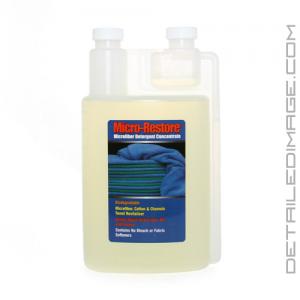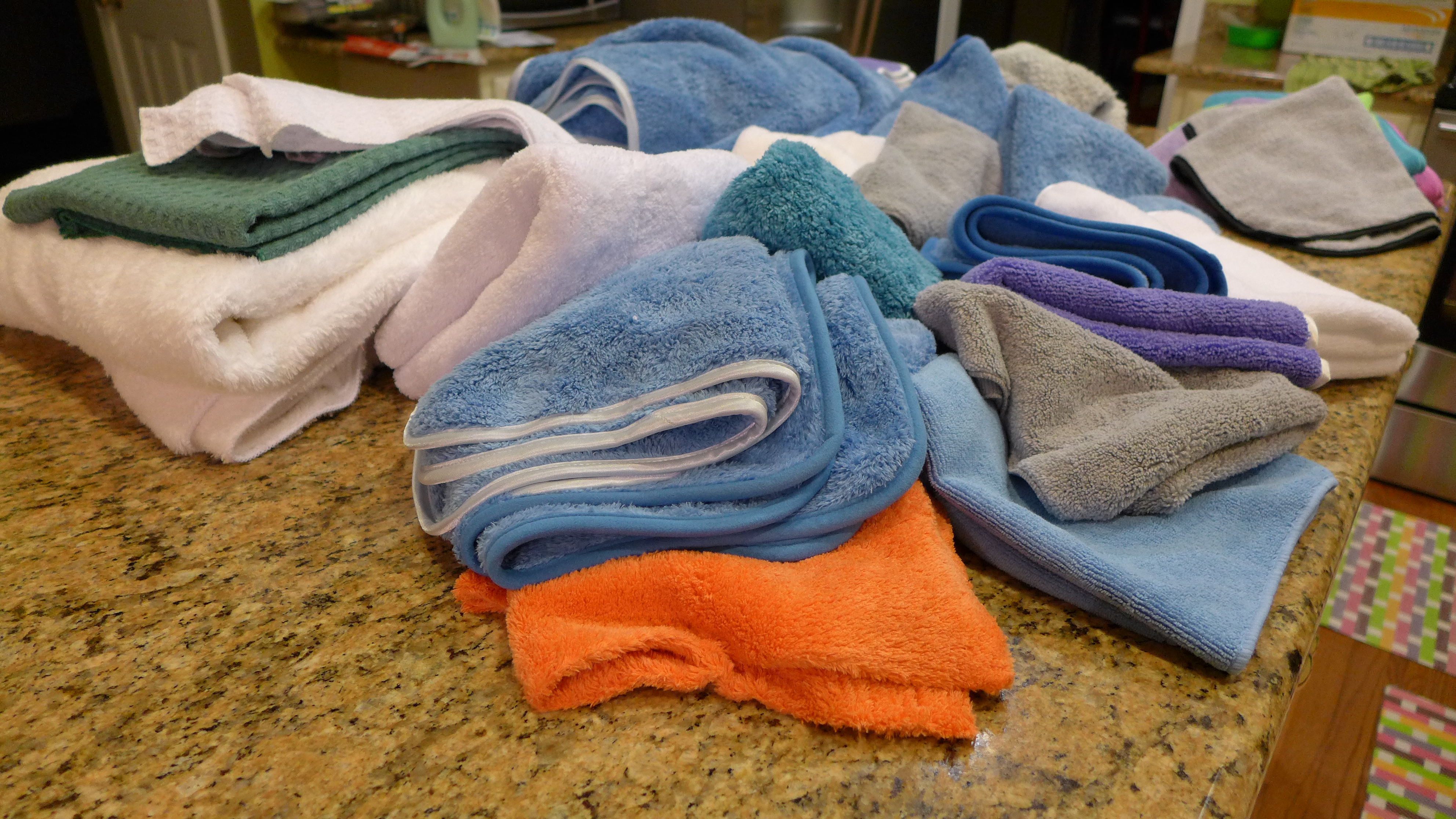Guide to Microfiber Towel Care
Ultimate Microfiber Towel Care Guide
How do you clean microfiber towels? Microfiber towel care is by far the most important maintenance for your cleaning supplies. This is Part 1 of the Liquid Finish Detailing’s complete microfiber guide. Great quality Korean microfiber towels can last up to 500 washes if properly cared for. However, polyester and polyamide fibers are very sensitive to improper cleaning regimens. Spoiling hundreds of dollars worth of towels can happen at any moment. In this microfiber care guide we will review:
- how not to care for your towels
- the available detergents on the car detailing market
- proper drying procedures
- the importance of white vinegar as a rinse agent
- proper task separation of each microfiber you own
- occasional “boiling water” reset procedures
- small-scale hand washing procedures
Before we dive into microfiber towel care, you may wonder which are some top microfiber suppliers? We recommend Pakshak Microfibers, TheRagCompany, and Microfiber Madness as tier 1 top of the line car microfiber detailing towels. You may read our recent review of TheRagCompany:
How NOT to Clean Microfiber towels:
NO FABRIC SOFTENER, BLEACH, & DRYER SHEETS
Bleach and softeners eliminate static charge. Softeners deposit a coating on the fibers which lead to loss of absorbency, cleaning power, and streaking.
NO CROSS CONTAMINATION OF TEXTILES
Microfibers are not to be washed with any cotton or textiles of any sort, strictly microfiber loads (applicator, bonnets). Cotton, or say steel wool, will simply detach their fibers and destroy the fibers by filling them with lint. If you happen to cross mix: try the Boiling Method and decontaminate your microfibers with a few washes. This MIGHT aid the problem.
NO IRONING
Microfibers should not wrinkle unless very wet, usually they flatten and are absorbent. If you fold into each microfiber into quarters you should have no problems.
Proper Microfiber Towel Care
-
#1 Separate your microfibers by Task & Purpose
- You should have 3 group of towels: paint delicates, all-purpose, and specialty. Paint friendly towels (Quick Detailing, Buffing, Drying) are the most delicate since they are the only objects touching your paint. Non paint towels would include all-purpose (wheel jams, wheels, metal work, engine), and interior towels. These are essentially downgraded towels not meant for delicate surfaces. Specialty towels such as glass, waffle weaves, and suede can be also separated.
-
#2 Pre Treat & Inspect your Washer & Towels
You can use an all-purpose cleaner to spray on exceptionally dirty spots. Inspect your laundry load to ensure light or heavy microfibers are not cross contaminated with non microfiber towels or exceptionally grimy towels.
You may create a heavy APC/Chemical solution to pretreat towels and dwell them overnight or for 1 hour. Use Meguiars Super Degreaser, Optimum Power Clean, Charlie Soap Laundry Detergent/All Purpose Cleaner.
Pretreat your washer with a quick white vinegar or laundry cleaner such as Charlie Soap to remove any residue in the laundry washer.
-
#3 Hot Water Wash
- I recommend 120F to 200F. Korean manufacturers suggest you wash at 60 Celcius. Just make sure the water is WARM to HOT. Consumer laundry machines are unable to melt the fibers (the temperature to melt polyester is 500F), so don’t be afraid to use mild to hot temperatures. Heat does ensure the release of dirt and contaminants. Extreme high heat can cause shrinking of polyamide or polyester, however most household water heaters do not exceed 140F.
-
#4 Chose a “Free” Detergent
- You will want a clean “free” rinsing detergent, no powders that leave residual crystals, no bleach, no softener, no perfumes. You may add all-purpose cleaners or degreasers such as Optimum Power Clean or Super Degreaser. Try to avoid harsh alkaline cleaners.
- Use about half the recommended amount of normal detergent, less is more. 1 – 2 Ounces per Standard Laundry Microfiber Load, observe manufacturer recommended dosage.
Most specialized microfiber washes are degreasers with scents to be more consumer friendly. MicroRestore has surfactants and emulsifiers to remove stains. As well it contains water softeners to reduce mineral deposits. MicroRestore is simply a strong modified degreaser (specifically it’s a modification of a garage degreaser and wheel cleaner, no cause for concern however).
- Household Cleaners: Tide Free, ERA, OxyClean, All Free & Clear
- Boutique Cleaners: Micro-Restore, Charlie Soap, Chemical Guys Microfiber Wash, Pinnacle Micro Rejuvenator, Detailer’s Pro Series Microfiber Cleaner, 3D Towel Kleen, Blackfire/Wolfgang
-
#5 Use White Vinegar (pH 2) with an Extra Rinse Cycle
- White Vinegar is a natural softener and rinse aid due to the acetic acid that breaks down any leftover residue from detergents or chemicals. White Vinegar has been used in the past as a natural softener and natural multipurpose cleaning chemical. It has many applications such as water spot removal and chemical cleaning.
- 1 Teaspoon per Towel in the Rinse Cycle. Most people just add 1/2 cup to 1 Cup per load.
Pakshak does not recommend the use of vinegar in frequent or large doses in your washing routine since it can leave residue that induces repellency. Too much will give you a crust like effect on your fibers.
- An extra rinse cycle is good; both before and after your microfiber load. Before you start your microfiber load, run white vinegar in a quick rinse cycle to remove any prior detergents or residue. For your final cleaning regimen, run white vinegar again to ensure no detergent, waxes, residue, or chemicals remain in the fibers.
-
#6 Line Dry or Low Heat
- While your residential laundry dryer cannot melt your microfibers, (some distributors believe so, but again the heat index is not possible by normal equipment) high heat overtime reduces the life of your microfiber significantly. Due to the high electrical charge that occurs when drying on high heat, microfibers are seriously damaged and lose their natural absorbency properties. Tumble dry or delicate dry your microfiber loads. The best practice is to simply line air dry. If you use a dryer, microfibers dry significantly faster (1/3 time wise) so be careful.
Microfiber Tips & Warnings:
- Color Bleeding: It is common to have color bleeding after the first or second wash. This doesn’t compromise the cloth since the dyes are filtering out. You may want to separate each color.
- First Wash: It is preferable to wash your microfibers before their first use to ensure no contaminants from the factory or transportation remain.
- Drop it, Demote it: If your happen to drop your microfiber during your detail, simply throw it aside. Grains of dirt, sand, or contaminants become attached to the microfibers and should be washed right away. Pollen and leaves are also dangerous. Overtime some microfibers do get saturated with dirt and grime, I suggest demoting these to all-purpose tasks such as wheel or interior duty.
- Storage: it’s best to store you microfibers so that no dirt or contaminants can be absorbed. Store the microfibers using zip lock bags or in plastic containers after a wash.
The Boiling Method (212 F)
- Boiling water breaks down the build up of chemicals, wax, sealants, cleaning products in the fiber.
- Korean manufacturers have recommended the use of “boiling” microfibers to ensure any of the dyes or contaminants from the factory are fully gone.
- Be careful of boiling timetables, limit up to 20 minutes. May fade dyes.
Have Microfiber Streaking or No Absorbency Issues?
- If you find water sits on the fibers as blobs or beads or the microfiber “pushes” water, most likely you have a case of cross contamination. Fibers were either contaminated with the wrong chemical, such as an improper detergent or softener. Boil you microfibers and redo your washing regimen.
- Inadequate cleaning regimen can occur if your not using pristine laundry washer, which is leaving chemicals in microfiber. Also too much detergent will have an affect.
Restoring Damaged Microfibers – Flash Method
- If you detail in a large amount there will be a time to reset or restore your microfibers. Essentially this method is a mix of the boiling/pretreat trick:
- boil hot water, get a large container, and dump the microfibers into the container
- add general cleaning chemicals (like Optimum Power Clean ), dump hot water, simmer those microfibers
- empty out, rinse the towels thoroughly
- start your normal laundry routine. Repeat if needed.
Small Microfiber Load? Hand Wash them!
If you have a small quantity of microfibers, you may wash them by hand:
- Find a clean sink or bucket, ensure clean by rinsing with an all-purpose cleaner or vinegar
- Fill appropriately with HOT water.
- Scrub microfibers with small amount of detergent or cleaner
- Empty water, fill with water and vinegar.
- Rinse microfiber
- Hang Dry
Proper Car Microfiber Towel Care
No Bleach, Softener, or Ironing.
1 Teaspoon of White Vinegar per Towel
1 to 2 oz of “free” Detergent per Standard Microfiber Load
Wash Only with Non-Linting Microfiber
Treat as Delicate with Tumble or Hang Dry
Further Reads: Detailed Image Microfiber Care
* While this video does a great summary, please note we recommend the dirt releasing power of hot water instead of cold water. *

Liquid Finish Detailing likes Charlie Soap since it is a dedicated special laundry detergent that removes harmful additives within most laundry detergents. Micro-Restore is a great specific cleaner for microfiber towel care. Just clean your microfibers often and immediately after usage so the chemicals can’t linger within the fibers. We find inspecting each towel before placing into an organized sealed environment really helps isolate any contamination that can occur. We prefer to use a towel in a light manner and to constantly wash to properly ensure a long lifespan. Proper microfiber towel care may seem intensive and laborious, however remember fibers are the only items that touch the delicate surface of your vehicle. Treat these towels like they are diapers for your baby. Would you wipe your finish or even your skin with something scratchy, dirty, or filthy? Remember the microfiber towel care breakdown:
- pre-treat and inspect microfibers
- add clean “free” detergent
- use hot water to release dirt
- add vinegar for an extra rinse agent
- air dry or tumble dry
Microfiber towel care doesn’t get harder than those five steps. Questions or concerns? Give us a shout:
Email: [email protected]
Call 919.901.0088 for your emergencies
Find us on Facebook.com/LiquidFinishDetailing
Tweet Us on Twitter: @LiquidFinish
We are on Google: Google+
Trackback URL: https://liquid-finish.com/guide-microfiber-towel-care/trackback/


Leave a Reply